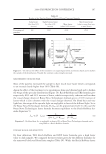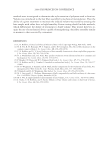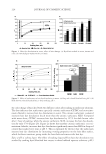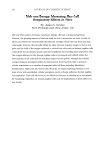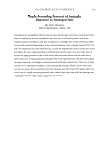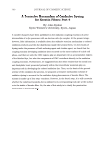2008 TRI/PRINCETON CONFERENCE 159 importance of chroma in luster sensation. For instance, shine and chroma, which are both refl ections, move along the hair fi bers according to the direction of illumination and ob- servation. This is typically observed for hair that is moving in the wind. It seems that there is currently no consensus on the shine being the only component play- ing a role in hair luster. In our research, we consider them playing an equal role and use the whole specular light to estimate luster. This equal role is chosen as the eye cannot make the difference between shine and chroma when they are overlapped and for very blond hair. Polarization which separates the refl ections from the diffused light, simplifi es the quan- tifi cation of luster sensation. LUSTER PARAMETER Luster is a term used to describe the state or quality of shining by refl ecting light. Luster qualifi es the visual appearance of the object. It is strongly linked to the idea of quality and beauty of an object. Scientists have tried to compute a parameter that would quantify the visual luster sensation (1,2,8,17). But obtaining one number that quantifi es the luster sensation is not straightforward. Luster is generally considered to depend on three main parameters (Figure 9): O The amount of specular light. The more specular light there is, the higher the luster will be. O The distribution/width of the refl ected light. For a same amount of refl ected light, the more defi ned and more concentrated the refl ected light is, the higher the luster will be. O The amount of background light on which the refl ection is observed. The darker the background is, the more contrasted the specular light appears and the higher the luster. Several luster formulae were developed and published by scientists using goniophotom- eters and other instruments to quantify human perception of Luster. The parameters used in the formulae are: O S the total amount (integral) of the specular light O D the total amount (integral) of the diffused light O θ1/2 the width of the specular light distribution Figure 8. Extraction of the shine and chroma bands from the specular profi le for blond hair. There is less shine than chroma. The chroma can be even higher for light blond hair.
JOURNAL OF COSMETIC SCIENCE 160 The four most used formulae are the Reich-Robbins, TRI, Stamm and Guiolet formulae (Equations 1). Among these, Reich-Robbins and TRI formulae are the most used. For instance, Reich-Robbins is the direct mathematical translation of the three basic assess- ments about Luster. Reich-Robbins Luster is directly proportional to the amount of spec- ular light S, so a two-fold increase of specular light results in a two-fold increase of Luster. It is also inversely proportional to the amount of diffused light, so if the background light is two times darker, the luster is two times greater. Finally, it is also inversely proportional to the angular width of the distribution so if the specular light width is divided by two, the specular light is twice as concentrated and the luster is two times greater. The TRI formula is similar to the Reich-Robbins one except that the diffused light is replaced by the specular plus the diffused light and that the luster is normalized by a reference angle. Stamm and Guiolet do not take into account the angular width of the distribution. L Re ich S D * −Robbins = 1/2 θ L TRI ref S S D = + θ θ 1 2 / (1) L S D S Stamm = − L Guiolet S D = Equations 1. The four most used luster formulae are the Reich-Robbins, TRI, Stamm and Guiolet formulae. USE OF PREVIOUS LUSTER FORMULAE WITH POLARIZATION DECOMPOSITION The previously described luster formulae were designed with mathematical separations of specular and diffused light (curve fi tting and other deconvolution methods). They give results that are well correlated to the visual perception with goniophotometric measurements. They can also be calculated with the physical separation of diffused and specular light distribution obtained with polarization. However, using these formulae, that were Figure 9. Luster is considered to depend on three parameters. (a) Increase of the amount of light refl ected. (b) Reduction of the width of the specular light while keeping the overall amount of specular light constant, so light is more concentrated for a smaller width. (c) Increase of the diffused light (background) while keep- ing the refl ected light the same.
Purchased for the exclusive use of nofirst nolast (unknown) From: SCC Media Library & Resource Center (library.scconline.org)














































































